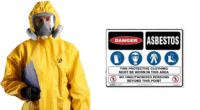How Do I Find Out If My Linoleum Flooring Contains Asbestos Or Not?
To find out if your Linoleum Flooring contains asbestos or not, you can do the following:
– Try to find a brand name (which is normally printed on the back of the Linoleum Flooring if you can lift it)
– Try to find the year it was produced (which is normally printed on the back of the Linoleum Flooring if you can lift it)
– Send a small sample of the Linoleum Flooring to a lab for testing (airsafe.net.au)
– Look at the backing of the Linoleum Flooring to see if it has a fibrous look
– It should also be noted that some adhesives that were used may also contain asbestos (most commonly a black look adhesive)
CONTACT AIRSAFE.NET.AU if your Linoleum Flooring was installed from the 1920s – 1980s to have a sample tested for ASBESTOS.
NOTE: WE DO NOT OFFER A SERVICE TO REMOVE ASBESTOS
Click Here To View Our Asbestos Warning Page For More Information
Click Here To View Our Linoleum Flooring Removal Page For More Information
It is common for people to install new flooring systems on top of asbestos Linoleum Flooring to reduce the cost of removing it before installing a new flooring system. If the Linoleum Flooring was installed from the 1920s – 1980s it’s important to contact AIRSAFE.NET.AU and have them check it out.
They will provide you with a report. If it does not contain asbestos, or if it does. If you receive an asbestos report showing there is no asbestos in the Linoleum Flooring, we are happy to proceed with the project.
If it comes up positive. You will need to find an Asbestos Removal Company that is licensed to do such work. (Once again AIRSAFE.NET.AU provides asbestos removal services) but there are plenty of other companies out there.
– Asbestos exposure can be a health risk. It is estimated that 4,000 Australians die EVERY year from asbestos-related diseases.
– Play it safe, disturbing, moving, touching, breaking, attacking, cutting, etc. Will cause asbestos to be released into the air, which sticks to your walls, roof, furniture, clothing, lungs, ETC.
– Asbestos exposure can be a health risk. It is estimated that 4,000 Australians die each year from asbestos-related diseases.
– Working with Linoleum Flooring Asbestos will release toxic dust and fibres into the air. Lack of awareness in the past has led to many workers suffering from terrible diseases today such as mesothelioma and asbestosis.
– Linoleum Flooring Asbestos is generally safe to be around. But that changes as soon as you decide to remove it or if the floor system becomes damaged.
– Old Linoleum Flooring asbestos products that contain Asbestos remain in many buildings across Australia, creating a hazard for contractors and do-it-yourself renovators.
– Often Linoleum Flooring may have multiple layers installed on top of each other. It’s not uncommon for a previous homeowner, DIY home renovator, or tradie to install a new layer on top of the old layer to save time and money. The layers underneath that are older may contain Asbestos.
– People who also try to DIY Remove Linoleum Flooring Removal themselves often forget that even if the Linoleum Flooring itself doesn’t have asbestos in it the glue can also, so without professionally removing it you create a future hazard for yourself and expose yourself to asbestos in the glue that was used to lay your Linoleum Flooring
Although sometimes Linoleum Flooring can contain Asbestos. Linoleum Flooring has been a popular choice for flooring and wallpaper throughout the modern era, and many Linoleum Flooring building materials manufactured before 1980 had asbestos mixed in to increase their durability, especially Linoleum Flooring Tiles.
– Workers must take many precautions to Remove Linoleum Flooring Asbestos Tiles safely as well as safely dispose of them.
– It is illegal to remove asbestos products without a CLASS A + CLASS B + SUPERVISOR LICENSE in Asbestos Removal.
– It is always safest to leave Linoleum Flooring Asbestos Tile removal to qualified professionals who are licensed by the Australian government.
